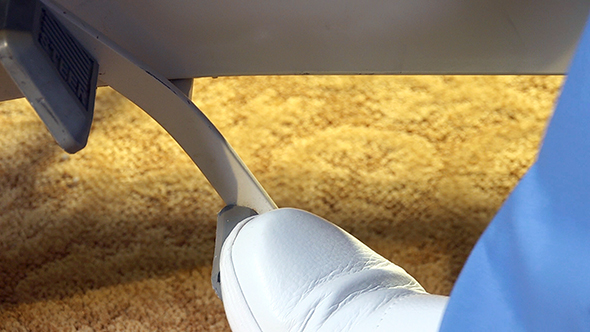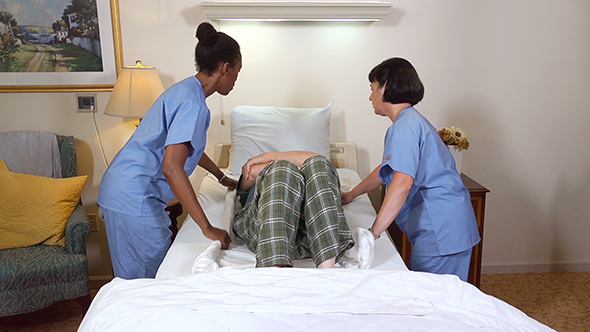Body Mechanics and Exercise
Select a Skill:
- » Moving the Person Up in Bed
- » Positioning the Person in Bed
- » Transferring the Person to a Chair or Wheelchair
- » Moving the Person to a Stretcher
- » Transferring the Person Using a Mechanical Lift
- » Assisting with Range-of-Motion Exercises
- » Helping the Person Walk
Take the Review Test:

Purpose

- When the head of the bed is raised, the person can easily slide down toward the middle and foot of the bed.
- You move the person up in bed for good alignment and comfort.
- Moving the person is best done with help and an assist device. With an assist device, the person is moved more evenly. The device also reduces shearing and friction.
- For lightweight adults, you can sometimes move them up in bed alone if they can assist using a trapeze.
- For heavy, weak, and very old persons, two or more staff members are needed.
- Always protect the person and yourself from injury.
Equipment
Roll cursor over items to see labels. For the purposes of clearly depicting the equipment, a barrier is not shown in this photo. When providing care, a barrier should always be placed on the surface before placing the equipment.

Drawsheet (lift sheet)
Folded flat sheet
Blue waterproof pad
Delegation
Follow delegation guidelines. Before moving a person, obtain this information from the nurse and care plan:
- What procedure to use
- How many staff are needed to safely move the person
- The person’s position limits and restrictions
- How far you can lower the head of the bed
- Any limits in the person’s ability to move or be repositioned
- What pillows you can remove before moving the person
- What equipment is needed
- If you need to apply an abdominal binder
- How to position the person
- If the person uses bed rails
- What observations to report and record
- When to report observations
- What patient or resident concerns to report at once
Preparation

- Observe quality-of-life measures.
- Review the information under Delegation and Safety and Comfort.
- Ask a co-worker to help you.
- Practice hand hygiene.
- Identify the person. Check the ID bracelet against the assignment sheet. Also call the person by name.
- Provide for privacy.
- Lock the bed wheels.
- Raise the bed for body mechanics. Raise the bed rails, if used.
Safety

- Use assist devices as directed by the nurse and care plan. Ask any questions before you begin the procedure.
- Move the person up in bed alone only if:
- The person is small, can follow directions, can assist with much of the moving, uses a trapeze, and can push against the mattress with his or her feet.
- The nurse says it is safe to do so.
- You are comfortable doing so.
- Be sure to lock the bed wheels before moving the person.
- Reusable underpads and other strong incontinence products can be used as assist devices. Ask the nurse if the person’s underpad is safe as an assist device. For safety, the underpad must:
- Be strong enough to support the person’s weight.
- Extend from under the person’s head to above the knees or lower.
- Be wide enough for you and the other staff to get a firm grip for the lift.
- To use a slide sheet, place it under the person. After moving the person, remove the slide sheet to prevent sliding down or off the bed.
- For persons with bariatric needs, the care plan may include:
- Performing the task with a friction-reducing device or bariatric lift and at least two or three staff members and placing the bed in Trendelenburg’s position.
- Leaving the friction-reducing device under the person and covering it with a drawsheet to reduce the risk of injuries.
Comfort
- This skill does not include comfort content.
Procedure Video
Audio Description: OFFFollow-up Care

- Put the pillow under the person’s head and shoulders.
- Position the person in good alignment. Raise the head of the bed to a level appropriate for the person.
- Provide for comfort.
- Place the call light and other needed items within reach.
- Lower the bed to its lowest position.
- Raise or lower the bed rails. Follow the care plan.
- Unscreen the person.
- Complete a safety check of the room.
- Practice hand hygiene.
Reporting/Recording
Report and record your observations, including:
- Who helped you with the procedure
- How much help the person needed
- How the person tolerated the procedure
- How you positioned the person
- Complaints of pain or discomfort
Review Questions
Select the best answer.
1. Which piece of equipment can you use to help move a person who can assist with moving up in bed?
Select the best answer.
2. For a person who cannot help with moving up in bed, what is the minimum number of staff members needed to move him or her with a lift sheet?
Select the best answer.
3. To move a dependent person up in bed, what should you do first?
 Place the bed in its lowest position
Place the bed in its lowest position Raise both side rails
Raise both side rails Raise the head of the bed
Raise the head of the bed Raise the bed to a good working height
Raise the bed to a good working height
Select the best answer.
4. Which safety guideline should you follow when moving a person up in bed?
 Face the foot of the bed
Face the foot of the bed Point your foot near the head of the bed toward the foot of the bed
Point your foot near the head of the bed toward the foot of the bed Bend at your hips and knees
Bend at your hips and knees Keep your back rounded
Keep your back rounded
Select the best answer.
5. To move a person up in bed, where should you hold a drawsheet?
 Near the person’s shoulder and hips
Near the person’s shoulder and hips At the handles
At the handles Close to the waist
Close to the waist Next to the person’s head and knees
Next to the person’s head and knees
You have completed the Review Questions for this skill. To take the Review again select the Start Over button. To proceed to another skill select from the dropdown menu. Select the Home or Back button to proceed to the next section.

